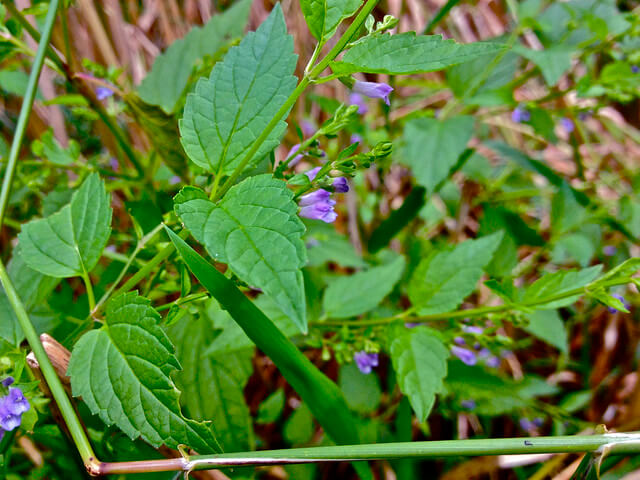Botanical Name: Scutellaria lateriflora
Common Name: Mad-dog Skullcap, Virginia Skullcap, Hood-wort, Helmet flower, Blue Pimpernel, Side-flowering Skullcap, Hooded Willow-herb, Mad-weed, Mad-Dog Weed
Actions: Neurotrophorestorative, anxiolytic, nerve tonic, anti-spasmodic, sedative, analgesic, anti-convulsive, anti-seizure, tonic, slightly astringent.
Traditional Use(s): Traditionally, it has been used as a nerve relaxant; it supports the nerves, quietening and strengthening the system. Skullcap, by its action through the cerebrospinal centers, is a valuable remedy for controlling nervous irritation. It is used in the case of hydrophobia insomnia, wakefulness, excitability, restlessness, Saint Vitus’ dance, hysteria, epilepsy convulsions, shaking palsy, rickets, bites of poisonous insects and snakes, and all nervous affections. It is also effective in reducing temperature and inducing perspiration in feverish children.
Parts Used: The whole herb.
Infusion of Scull Cap
Ingredients:
1 1⁄2 ounces Scull Cap Herb (cut)
1 1/4 pints distilled water.
Direction:
- Boil the water, and while boiling, pour over the Herbs.
- Cover, and allow to steep in a hot place for 30 minutes.
- Strain and sweeten with honey.
- When cold, bottle and keep in a cold place.
Dose: 1 wineglassful 3 or 4 times a day. Children, less according to age.
Note: can be taken in larger doses, in severe cases.
Sleeplessness: for sleeplessness, heat a cupful and drink hot, on going to bed.
Hydrophobia: For hydrophobia, a teacupful every hour (taken warm), until the symptoms subside.
Epilepsy: For epilepsy in adults, a stronger infusion should be made, using 2 or even 3 ounces of the herb to each pint of distilled water, and steeped the same as directed in above formula. The dose for adults, of this strong infusion, is a wineglassful 3 or 4 times a day. May be diluted with water if desired, and drunk in teacupful doses. Continue the treatment for several weeks, or even longer if necessary.

Scullcap Infusion
Ingredients:
1/2 once recently dried leaves or herb
1/2 pint of boiling water
Direction:
- Add herb to cup and then pour over hot water.
OR
Hot Infusion: Pour 1 cup of boiling water over 1-2 teaspoons of dried herb and infuse for 10 to 15 minutes. Drink three times a day or as needed (Hoffmann, 2003). This will make a very strong infusion.
Hydrophobia: For hydrophobia, a teacupful every hour (taken warm), until the symptoms subside.
Epilepsy: For epilepsy in adults, a stronger infusion should be made, using 2 or even 3 ounces of the herb to each pint of distilled water, and steeped the same as directed in above formula. The dose for adults, of this strong infusion, is a wineglassful 3 or 4 times a day. May be diluted with water if desired, and drunk in teacupful doses. Continue the treatment for several weeks, or even longer if necessary.
Scull Cap is quite harmless, and can be taken in larger doses, in severe cases.
Scull cap Tincture
Tincture: of fresh plant 1:2 (75% EtOH: 25% water); of dried plant 1:5 (50% EtOH: 50% water)(Cech, 2000); of fresh plant 1:2 95% EtOH
For irritable and nervous conditions:
Tincture of lady’s slipper (Cypripedium pubescens), 10–20 drops
Tincture of skullcap (Scutellaria laterifolia), 2–15 drops
In warm water every 2–4 hours.
For insomnia or exhaustion, whether from excessive application to business or due to alcoholism:
Tincture of skullcap (Scutellaria laterifolia), 2–12 drops
Tincture of passion flower (Passiflora incarnata), 15–40 drops
In water every 3 hours, or more frequently depending on age and condition.
Dose: Tincture alone, 3–12 drops in water as indicated. As an infusion, 1 teaspoonful of the cut or powdered herb steeped in 1 cupful of boiling water for 1/2 hour; take every 3–4 hours for adults; in proportion for children.
Reference(s)
Dr Edward Shooks. Elementary Treatise in Herbology
This article is copyrighted by Ital is Vital, 2025. Want to re-post this article? Visit our guidelines.
DISCLAIMER: THIS WEBSITE DOES NOT PROVIDE MEDICAL ADVICE
The information, including but not limited to, text, graphics, images and other material contained on this website are for informational purposes only. The purpose of this website is to promote broad consumer understanding and knowledge of various health topics. It is not intended to be a substitute for professional medical advice, diagnosis or treatment. Always seek the advice of your physician or other qualified health care provider with any questions you may have regarding a medical condition or treatment and before undertaking a new health care regimen, and never disregard professional medical advice or delay in seeking it because of something you have read on this website.
